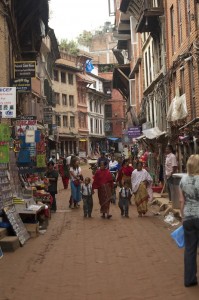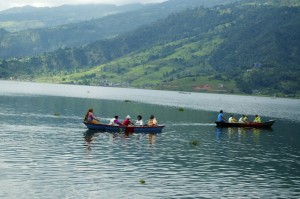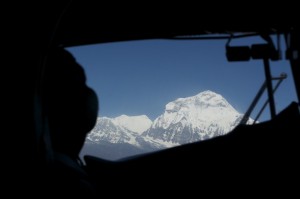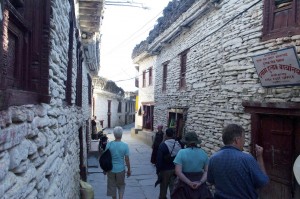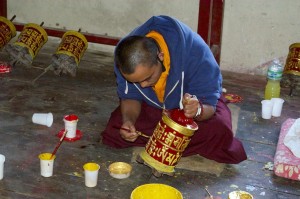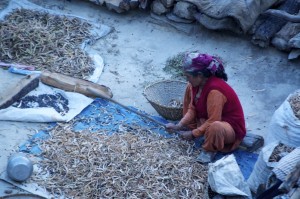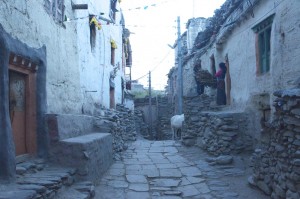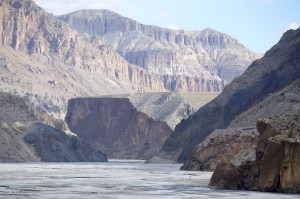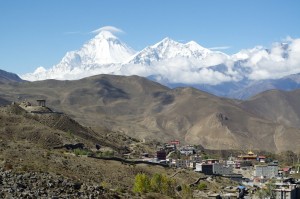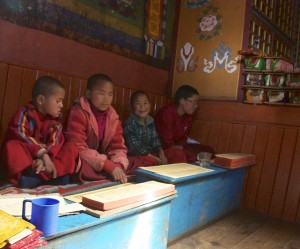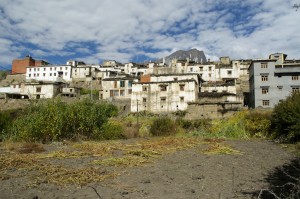When I left Nepal last April I left rather disillusioned with the lack of organisation, frustrated by the dirt and chaos, the slow pace of progress and the constant battle with traffic, crowds and street hawkers. Travelling to Nepal again in October, I forgot about those niggling criticisms and found myself excited. Perhaps it was because I had no responsibilities beyond enjoying the trek and looking after the twelve people with me. Whatever the reasons I keenly peered out of the window as our plane descended towards Kathmandu through cloud, eventually emerging to see a green, lush landscape beneath us. The heavy monsoon rains of the summer had transformed the land from varying shades of brown to shades of vivid green. The so dominant brick factories during the dry season were lost in a sea of green. It was raining so perhaps the monsoon was not yet finished.
Having landed the pilot welcomed us to Kathmandu and told us it was 5.15 in the afternoon. It was, in fact, 3.15. I am glad that was the only dial he got wrong on his approach to the airport.
October is usually a dry month in Nepal but, although the month was still in its infancy, there had been several days of rain turning the often unsurfaced roads and pavements into a sea of mud. The road widening that had been taking place for two years was still not finished, adding to the poor travelling conditions. Thankfully we had arrived on a Saturday, the quietest day of the week on Kathmandu’s roads.
Virtually all of the group had been to Nepal before so, the following morning, instead of heading for the usual tourist spots of Pashupatinath and Swayambunath, we headed for the quieter Bhaktapur. Having been there only six months earlier during the New Year celebrations it was good to see it on a normal working day as people went about their daily business. Bhaktapur is like a living museum where you gain a much better insight into the lives of those who live there than you do in both Kathmandu or Patan. It is a little reminiscent of an old peoples’ home. There are so many old people, bent almost double with years of toil, shuffling about the narrow streets and squares doing what they can or just making themselves go out to maintain some level of mobility. Being out must be preferable to sitting in a darkened room.
The highlight for me, as always, was the pottery square, full of colour and activity.
Women bent double turning pots to dry in the sun, men producing more at an alarming 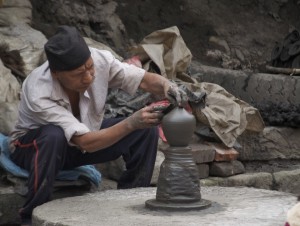 rate on a wooden wheel which they turned with a stick between each pot thrown, men sweeping out a recently used fire while another was being prepared. Everything was done with maximum efficiency and no fuss; everybody knew their job and got on with it without the need for instruction, a well tried system that probably hasn’t changed in decades. Chickens wandered among the pots picking bits from in between. A child, probably only a year old sat among the pots while her mother moved them around. Given a pot to play with, she rolled it around until the top broke off. Clearly the child was in charge of quality control.
rate on a wooden wheel which they turned with a stick between each pot thrown, men sweeping out a recently used fire while another was being prepared. Everything was done with maximum efficiency and no fuss; everybody knew their job and got on with it without the need for instruction, a well tried system that probably hasn’t changed in decades. Chickens wandered among the pots picking bits from in between. A child, probably only a year old sat among the pots while her mother moved them around. Given a pot to play with, she rolled it around until the top broke off. Clearly the child was in charge of quality control.
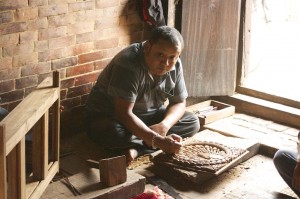 In another square we watched wood carvers at work. The detail they were carving to make windows or ornamental pillars was very intricate, but the remarkable thing was the light in the area they were working. The light quality was extremely poor and it is hard to believe that they could produce such fine work and also not damage their eyes.
In another square we watched wood carvers at work. The detail they were carving to make windows or ornamental pillars was very intricate, but the remarkable thing was the light in the area they were working. The light quality was extremely poor and it is hard to believe that they could produce such fine work and also not damage their eyes.
Finishing our visit to Bhaktapur the bus returned us to Thamel for lunch. The traffic was so congested it turned into a late lunch at Gaia before we went to Shona’s to buy kit and Azam’s little jewellery shop. He was not his usual chirpy self, having recently lost his mother and taken the loss badly.
The following morning we had a leisurely breakfast before heading off to the airport for a civilised 11.05 flight to Pokhara. Traffic was moving well until we came to a crossroads controlled by a policeman. There the minutes ticked away as he gave priority to the traffic on the ring road, leaving us waiting for fifteen minutes. On the other side of the crossroads is Pashupati, now a World Heritage Site and undergoing some major developments, including the building of a crematorium. While this will be a much more efficient method of cremation and take away the voyeuristic aspect where tourists openly photograph the ceremony of cremation, I am guessing that there will be some who will continue to prefer the traditional methods on the ghats overlooking the river.
Domestic departures was heaving with trekkers heading for the hills with the preference seeming to be Everest. Rising above the cloud afforded us clear views of dramatic snowcapped peaks.
Pokhara was warm and sunny and a short minibus ride took us to Lakeside View Retreat, a new boutique type hotel which afforded no lakeside view. Having settled in we went our own way to explore Pokhara and have some lunch. Pokhara is nothing like Kathmandu. The streets are relatively traffic free, there is little or no pressure from shopkeepers to patronise them and there is a much more relaxed atmosphere. It is a resort town. Joining Mike and Julie we took a boat out on the lake for a couple of hours. It was a thoroughly relaxing afternoon, the main attraction watching a tribe of monkeys on the far shore and marvelling at the vast numbers of butterflies.
The following morning I got up for the mountain view but my optimism of the night before that it would be clear proved fruitless. A band of cloud obliterated the view.
After an early breakfast we headed off for the airport for a 7.55am flight to Jomsom. Leaving Ramesh to deal with the check-in we sat on the roof of the departures building and watched the mountains gradually appear as the cloud began to dissolve. The flight was delayed by three hours and we finally got away at 11.00am. The flight from Pokhara to Jomsom is stunning and once we emerged from the cloud we were rewarded with the entire Annapurna range. It was not long before Dhaulagiri could be seen over the pilot’s shoulder and then to our left as we headed up the Kali Gandaki Valley. It has to be one of the world’s most spectacular short flights
Having landed we went to a lodge in Jomsom to sort out our kit before heading back down the valley to Marpha, a walk of a little over an hour. The history behind Marpha is that in 1899 a Japanese monk, Ekai Kawaguchi stayed there on his journeying. His objective was to get into Tibet at a time when Tibet was closed to the outside world. As a result he spent quite some time in Marpha, was made welcome and became attached to the community. Since then the Japanese have patronised the village, have maintained their attachment, and generously given annual scholarships for the children of Marpha to study in Japan.
It is the smartest and cleanest Nepalese village I have ever seen. The streets are paved and all the houses, made of stone, have been whitewashed. The streets are clean. Dominating the village is a large monastery, the Rinjin and Solmi Gompa, built on many levels up the hillside. It too is clean and well cared for. There seemed to be bit of a makeover taking place in preparation for a prestigious visitor. All the prayer wheels were being taken off their spindles and given a fresh coat of paint.
A young monk opened up the gompa and, through Ramesh, told us all he knew of the monastery. He was eight years old but brimming with confidence. From the outside terraces we had good elevated views into the labyrinth of passages linking the houses together. The roof is where everything is done from beating the vines of beans with a stick to extract the beans from the pods to drying goat skins in the sun. There were many shops in the village but very little business. I am sure there must be a great many visitors to Marpha during the course of a year but I also suspect that the road, which bypasses the village, encourages people to go passed without stopping.
There is more to Marpha than at first meets the eye. It has a thriving artist community but I suspect it is best known for its apples. It is surrounded by apple orchards. Where we were camping had an outhouse with a strong apple aroma. Many of the apples are cut into slices and dried. There is a solar drying syatem in the village but it does look as if it has seen better days. Some apples are distilled to produce a locally famous spirit, Marpha Apple Brandy. I was very impressed with Marpha.
The following morning we returned to Jomsom by the same route we had taken the previous day and continued up the Kali Gandaki Valley to Kagbeni. Towards the end of the walk the wind developed and the grains of sand and grit picked up tingled against our legs. We arrived in time for lunch and used the Paradise Hotel as our mess tent.
In the afternoon we explored Kagbeni. From a distance it doesn’t look as if it has changed much in the eleven years since my last visit but now, walking through the narrow streets it was easy to appreciate that there has been a lot of development. The most significant is at the monastery. All the surrounding buildings have been replaced. These house the monastic accommodation and the school, which seems to be a new addition to the role of the monastery. A new gompa is in the early stages of building, adjacent to the five hundred year old one, which despite being made of mud walls is still standing. The speed at which the new gompa is built is very much dependent upon donations from passing trekkers like us. The young 18 year old monk was quick to tell us of the importance of funds, prior to us making a generous donation out of the kitty.
Down by the river there is a small Hindu temple which I don’t remember seeing before and must be there as a result of the road development. Here, devotees can step safely into the very cold, fast flowing Kali Gandaki, which has religious significance, and immerse themselves or not depending on the strength of their devotion.
The old part of the village within the old fort has not changed. It is amazing that it is still standing, the mud walls having eroded in the daily winds that batter them, forcing cracks into their weakest points. Finishing up at the check point entrance to Upper Mustang we looked up the valley. I had the same fascination for what was up there and around each bend that I had when I first saw it in 1999. The only difference this time was that I would soon find out what was up there and around the bends.
Using the next day as an acclimatisation day we took land cruisers up to Muktinath. Again there had been a lot of buiding work and development with new hotels and a new temple. Some things were still the same with the weaving looms lining the main street and the strangely named Bob Marley Bar. On my previous visits to the religious sites of Muktinath there had been very few pilgrims, largely because it took a great deal of effort to get there. Today, while not crowded, there were significantly more and I can attribute this to the road, making it a lot more accessible. However, the road does not go all the way to the shrines and temples. Most people have to walk the last half mile, up hill to the entrance. For those who are either lazy or incapable there is a motorbike pillion service which will take you to the entrance. While we were there a motorbike delivered an elderly woman, bent double, to the entrance where younger members of her family took over the responsibility of looking after her.
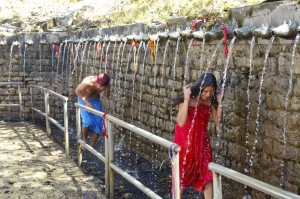 Inside, the pilgrims, undaunted by non-Hindus watching them changed out of their day clothes for the various watery ceremonies they were to undertake. The women wore thin silk saris while the men stripped down to their underwear. They then either walked under the 108 water spouts gushing icy, cold water or, if they were less brave rather than less devout, they walked by each spout spraying a little water on to their heads with their hand. The old woman we saw arriving earlier walked through each spout. Having completed this ritual they had two pools to immerse themselves in. Again, the degree of immersion was very much left to the individual. Some just went waist deep while others totally immersed themselves. The first pool was to wash away their sins while the second represented virtue. Now, having completed the watery part of their pilgrimage, they dried and dressed so that they could enter the temple with offerings to the gods. We were not able to see what was happening in this part of the ceremony.
Inside, the pilgrims, undaunted by non-Hindus watching them changed out of their day clothes for the various watery ceremonies they were to undertake. The women wore thin silk saris while the men stripped down to their underwear. They then either walked under the 108 water spouts gushing icy, cold water or, if they were less brave rather than less devout, they walked by each spout spraying a little water on to their heads with their hand. The old woman we saw arriving earlier walked through each spout. Having completed this ritual they had two pools to immerse themselves in. Again, the degree of immersion was very much left to the individual. Some just went waist deep while others totally immersed themselves. The first pool was to wash away their sins while the second represented virtue. Now, having completed the watery part of their pilgrimage, they dried and dressed so that they could enter the temple with offerings to the gods. We were not able to see what was happening in this part of the ceremony.
We spent quite a long time soaking up the atmosphere, people watching. Occasionally they would talk to us and explain some of the things they were doing. From there we moved on to the Buddhist part of the complex and the nunnery where the nuns were seated around chanting. They ranged in age from about eight to sixty, all wearing their red nun’s habits but often with a down jackets over the top. The fascinating thing about this experience was that they could join in and drop out of the chanting as they pleased. Some were keen to be distracted and to observe us. They didn’t seem to be chanting from the same books but there was nothing discordant about the sound they were making. It was very relaxing to sit cross legged on the floor, close our eyes and drift wherever our thoughts took us.
After lunch we walked back to Kagbeni via Jharkot. I remember it being a super walk, and it still is, but it is spoilt now because significant stretches of it have to follow the road. Whilst this makes the walking easier, and, despite the fact that there is very little traffic, it becomes tedious.
As I went to sleep that night my mind passed through the check point into Upper Mustang. I was looking forward to a new experience and the next day it would be more than my mind going into the Hidden Kingdom of Mustang.

